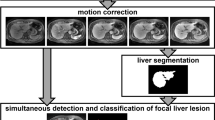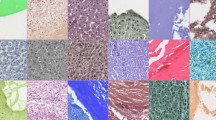Abstract
Hepatic echinococcosis (HE) is a life-threatening liver disease caused by parasites that requires a precise diagnosis and proper treatments. To assess HE lesions accurately, we propose a novel automatic HE lesion segmentation and classification network that contains lesion region positioning (LRP) and lesion region segmenting (LRS) modules. First, we used the LRP module to obtain the probability map of the lesion distribution and the position of the lesion. Then, based on the result of the LRP module, we used the LRS module to precisely segment the HE lesions within the high-probability region. Finally, we classified the HE lesions and identified the lesion types by a convolutional neural network (CNN). The entire dataset was delineated by the hospital’s senior radiologist. We collected CT slices of 160 patients from Qinghai Provincial People’s Hospital. The Dice score of the final segmentation result reached 89.89%. The Dice scores, indicating the classification accuracy, for cystic vs. alveolar echinococcosis and calcified vs. noncalcified lesions were 80.32% and 82.45%, the sensitivities were 72.41% and 75.17%, the specificities were 83.72% and 86.04%, the NPVs were 80.01% and 86.96%, the PPVs were 80.45% and 81.74%, and the areas under the ROC curves were 0.8128 and 0.8205, respectively.

Graphical abstract






Similar content being viewed by others
References
Czermak B, Akhan O, Hiemetzberger R, Zelger B, Vogel W, Jaschke W, Rieger M, Kim SY, Lim JH (2008) Echinococcosis of the liver. Abdom Imaging 33:133–143. https://doi.org/10.1007/s00261-007-9331-0
Bhutania N, Kajal P (2018) Hepatic echinococcosis: a review. Annals of Medicine and Surgery 36:99–105. https://doi.org/10.1016/j.amsu.2018.10.032
Moro P, Schantz PM (2009) Echinococcosis: a review. International Journal of Infectious Diseases 13:125–133. https://doi.org/10.1016/j.ijid.2008.03.037
Kammerer S (1993) Echinococcal disease. Infictious Disease Clinics of North America 7:605–618 https://europepmc.org/abstract/med/8254162
McManus DP, Zhang W, Li J, Bartley PB (2003) Echinococcosis. Lancet 362:1295–1304. https://doi.org/10.1016/S0140-6736(03)14573-4
Brunetti E, Kern P, Vuitton DA (2010) Writing panel for the WHO-IWGE, expert consensus for the diagnosis and treatment of cystic and alveolar echinococcosis in humans. Acta Trop 114(1):1–16. https://doi.org/10.1016/j.actatropica.2009.11.001
McManus DP, Gray DJ, Zhang W, Yang Y (2012) Diagnosis, treatment, and management of echinococcosis. BMJ 344:e3866. https://doi.org/10.1136/bmj.e3866
LeCun Y, Bengio Y, Hinton G (2015) Deep learning. Nature 521(7553):436–444 https://www.nature.com/articles/nature14539
Jia L, Fang C, Changcun P, Mingyu Z, Xinran Z, & Liwei Z (2018) A cascaded deep convolutional neural network for joint segmentation and genotype prediction of brainstem gliomas. IEEE Trans Biomed Eng 1-1. https://doi.org/10.1109/TBME.2018.2845706
Chen F, Liu J, Zhao Z, Zhu M, & Liao H (2017) 3d feature-enhanced network for automatic femur segmentation. IEEE J Biomed Health Informatics 1-1. https://doi.org/10.1109/JBHI.2017.2785389
Ronneberger O, Fischer P, Brox T (2015) U-net: Convolutional networks for biomedical image segmentation. In: International Conference on Medical image computing and computer-assisted intervention. Springer, Cham, pp 234–241. https://doi.org/10.1007/978-3-319-24574-4_28
Hänsch A, Schwier M, Gass T, Morgas T, Haas B, Dicken V, Meine H, Klein J, Hahn HK (2019) Evaluation of deep learning methods for parotid gland segmentation from CT images. J Med Imaging 6(1):011005. https://doi.org/10.1117/1.JMI.6.1.011005
Liu J, Chen F, Pan C, Zhu M, Zhang X, Zhang L, Liao H (2018) A cascaded deep convolutional neural network for joint segmentation and genotype prediction of brainstem gliomas. IEEE Trans Biomed Eng. https://doi.org/10.1109/TBME.2018.2845706
Menze BH, Jakab A, Bauer S, Kalpathy-Cramer J, Farahani K, Kirby J, Lanczi L (2015) The multimodal brain tumor image segmentation benchmark (BRATS). IEEE Trans Med Imaging 34(10):1993–2024. https://doi.org/10.1109/TMI.2014.2377694
Dou Q, Chen H, Jin Y, Yu L, Qin J, Heng PA (2016) 3D deeply supervised network for automatic liver segmentation from CT volumes. In: International conference on medical image computing and computer-assisted intervention. Springer, Cham, pp 149–157. https://doi.org/10.1007/978-3-319-46723-8_18
Esteva A, Kuprel B, Novoa RA, Ko J, Swetter SM, Blau HM, Thrun S (2017) Dermatologist-level classification of skin cancer with deep neural networks. Nature 542:115–118. https://doi.org/10.1038/nature21056
Litjens G, Kooi T, Bejnordi BE, Setio AAA, Ciompi F, Ghafoorian M, van der Laak J, van Ginneken B, Sánchez CI (2017) A survey on deep learning in medical image analysis. Med Image Anal 42:60–88. https://doi.org/10.1016/j.media.2017.07.005
Funding
The authors would like to acknowledge the supports of National Natural Science Foundation of China (81771940, 81427803), National Key Research and Development Program of China (2017YFC0108000), and Beijing Municipal Natural Science Foundation (7172122, L172003).
Author information
Authors and Affiliations
Corresponding author
Ethics declarations
Conflict of interest
The authors declare that they have no conflict of interest.
Human participants or animals
This article does not contain any studies with human participants or animals performed by any of the authors.
Informed consent
Informed consent was obtained from all individual participants included in the study.
Additional information
Publisher’s note
Springer Nature remains neutral with regard to jurisdictional claims in published maps and institutional affiliations.
Rights and permissions
About this article
Cite this article
Xin, S., Shi, H., Jide, A. et al. Automatic lesion segmentation and classification of hepatic echinococcosis using a multiscale-feature convolutional neural network. Med Biol Eng Comput 58, 659–668 (2020). https://doi.org/10.1007/s11517-020-02126-8
Received:
Accepted:
Published:
Issue Date:
DOI: https://doi.org/10.1007/s11517-020-02126-8




